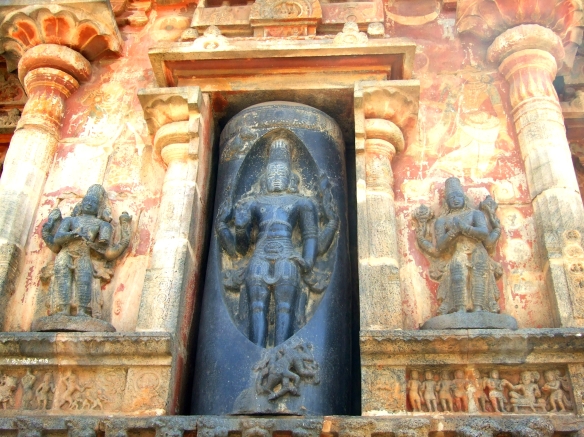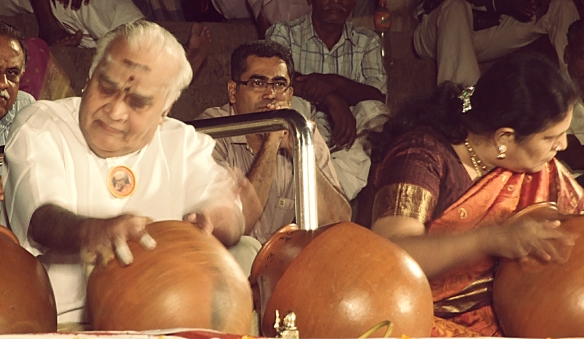to read about day 1 of the festival and our trip, click here
To the strains of a poignant MuteMath we traversed through green lush by means of a dented state highway that connects Thanjavur to Kumbakonam. Our destination was Darasuram, a small village in the Thanjavur district a few kilometers before Kumbakonam. Here we visited the Shiva temple (local name – Airavatesvara, which is another name for Shiva). Built in the 12th century by one of the Chola Kings – Rajaraja Chola the second, the temple is now a UNESCO World Heritage Site.
This was a real gem in terms of art and architecture as it had some of the most exquisite and well preserved stone carvings we’d ever seen. One of them being the horse-drawn chariot in the main mandapa, which has been carved to some truly amazing detail.
We bewilderingly walked through the different parts of the temple, every inch of which was carved with ancient stories about Hindu mythology and/or life in the times of the Chola dynasty. The expansive scale and extravagant architectural style of these temples show that these ostentatious rulers truly wanted to leave their mark in history.
Amongst the members of our entourage was VR Devika, who had mentioned that she would be talking about some of the carved depictions at this temple so we followed her around with the hope of gathering some such info. She turned out to be a storehouse of knowledge of all things South Indian and the seemingly still and nondescript carvings of Lord Siva came alive with the vibrant details of her parables. Here’s one where she comes upon an important carving (in granite) of Shiva as Lingodbhava (shown below):
There were many more interesting and magical stories plucked out of Hindu mythology and amidst all the enlightenment, the concept of ‘ganaas’ stood out as a short and sweet anecdote.’Ganaas’ are the little creatures who were part of Shivas clan and are always spotted in depictions relating to Shiva and we saw several of them at the Airavatesvara temple. We asked Devika who or what they were to which she casually answered, with a smile :
“ganaas are the unexplained phenomenon.
Like a sudden cool breeze on a hot day.”
We spilt from the rest of the group (who were lured by some silk weavers in the temple complex) to head back to Thanjavur to get a good meal and some rest before the evening’s performances began. Sri Sivas Hotel near the Thanjavur state bus stand served us a nice and satisfying South Indian meal on a plantain leaf that was complete with butter milk (‘more‘) and vathal kozhumbu (A:7 M:5.5)
Come evening, we were back on the road to Thiruvaiyaru and the music. The evening’s program was an interesting mix and was being held at a new venue. We didn’t know what to expect until we were crossing the bridge over the Cauvery and saw it in the distance. It was now that we realized that beautiful venues were going to be the signature of this festival.
The river Cauvery is one of the lifelines of Tamil Nadu as far as the water supply is concerned. Between the lack of rains in the last monsoon and the water dispute with Karnataka, the river has been rendered dry and lifeless at Thiruvaiyaru. It was at one of the ghats here where the stage was setup for the evening’s concert. We entered the doors of the Pushya Mahal, which had been set up and tastefully lit in true festival spirit. The stage and the mahal behind it looked brilliant in hues of pink and blue from the crowd perspective (which was in the river bed), but what looked even more stunning were the heritage buildings, which were an ancient housing complex for the Queen’s ‘ladies in waiting‘, converted into a girls’ hostel which had been intelligently lit up to add a really special extension to the main stage. It felt great to stand within this awesome setting in the river bed while we watched the sun go out. Some bhajans were being rendered by the little girls who won the local bhajan competition held by the Prakriti Foundation the previous day.
The bhajans were followed by a Ganga Aarti program by three young Pandits who had been brought down from Varanasi to perform the aarti as a prayer for a fully fledged monsoon and a flowing Cauvery in the coming year. This ritual was unfortunately set to a recording of some chants and devotional songs rather than live music, which was a real dampener considering the nature of the setting and the feelings that it evoked inside us.
Fortunately, the best act was kept for the last. A capacity crowd (600 odd) gathered to watch one of the musical ambassadors of India close the show with his group ‘Saptaakshara.’ For those who do not know of him, Vikku Vinayakram is not just a leading percussionist. He is a ghatam exponent who has brought the instrument into the limelight and given it a voice over the past few decades.
However, with this group he showed how artistes should never let their accolades take over their art by stitching together a beautiful ensemble of instruments that genuinely defined the school of Carnatic percussion through a set of pleasing melodic arrangements. The group featured Vikku Vinayakram [ghatam(s)] and his team of son Mahesh (carnatic vocal), student Sukanya Ramgopal (ghatam) ,grandson V Swaminathan (khanjira) and A.Ganesan (morsing). The set consisted of songs that employed the use of konokol (the format of speaking out the beats of a rhythmic pattern) to craft melodies and progressions embellished with some tasteful vocal improvisation. The percussion ensemble sailed through 90 minutes+ led by the flawless performance of the leader Vikku Vinayakram who took his immensely talented group through some really intricate and interesting changes that thoroughly enthralled the audience. Amidst the unique features of the group was the multiple ghatam setup of different tunings by Vikku Vinayakram that added a really sweet harmonic element to the song arrangements. Listen to a song from their performance that opens with the vedic chant – totakashtakam, which is a poem of 8 stanzas by Totakacharya in praise of his Guru Shri Adi Shankaracharya.
After the disappointing music showcase on day 1, this day ended on a great note with this refreshing performance and just when we were ready to go back, our gracious host Ranvir Shah (founder of the Prakriti Foundation) invited us to a post concert tete-a-tete that he had organized at the palace, where we caught up with our fellow festival cohorts and unwound with some good relaxed conversations about the lives that we hail from.
Not to forget the food that was an important aspect of this trip for us. Yet again, it didn’t fail to stir the innards of our souls with its mightily appealing simplicity. Be it the paniyarams served this night or the elay sapada (banana leaf meal) we were to be served the following day (read our next entry for details) the bliss experienced following every meal was consistent on this maiden voyage together.
Breakfast couldn’t come any sooner!










